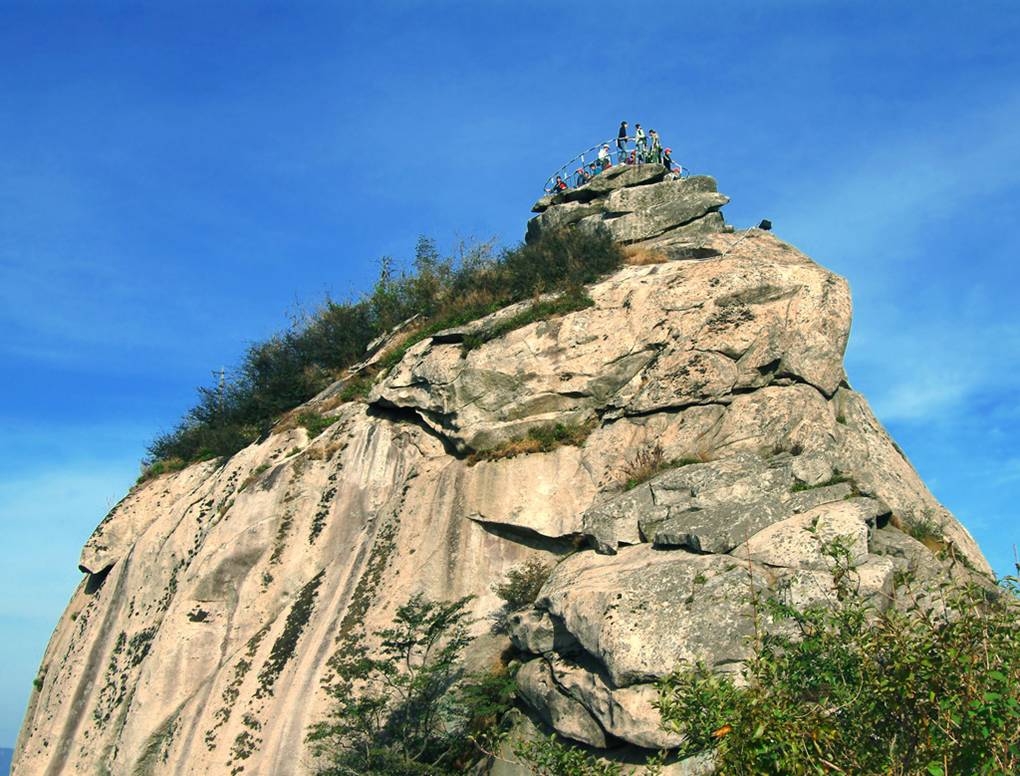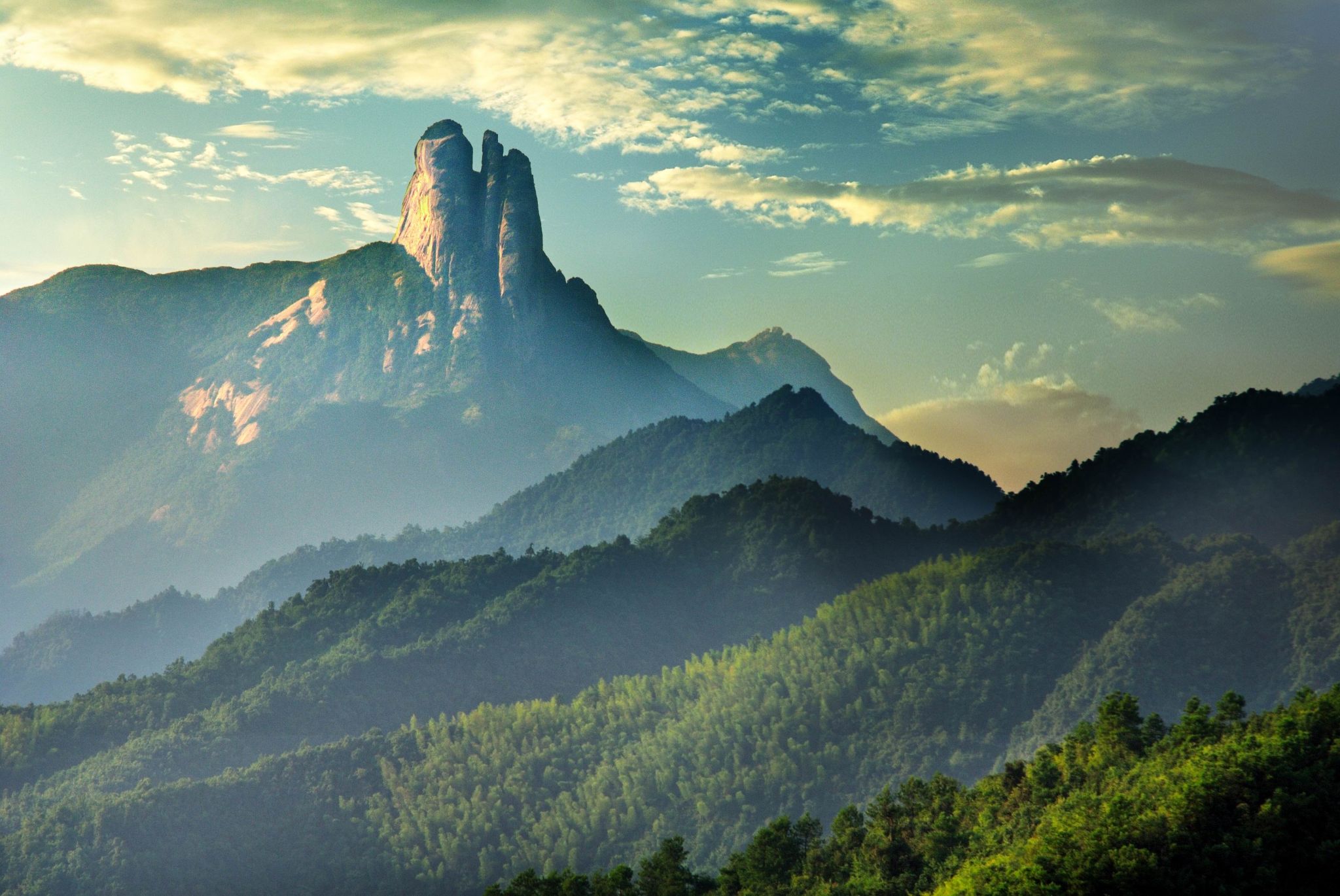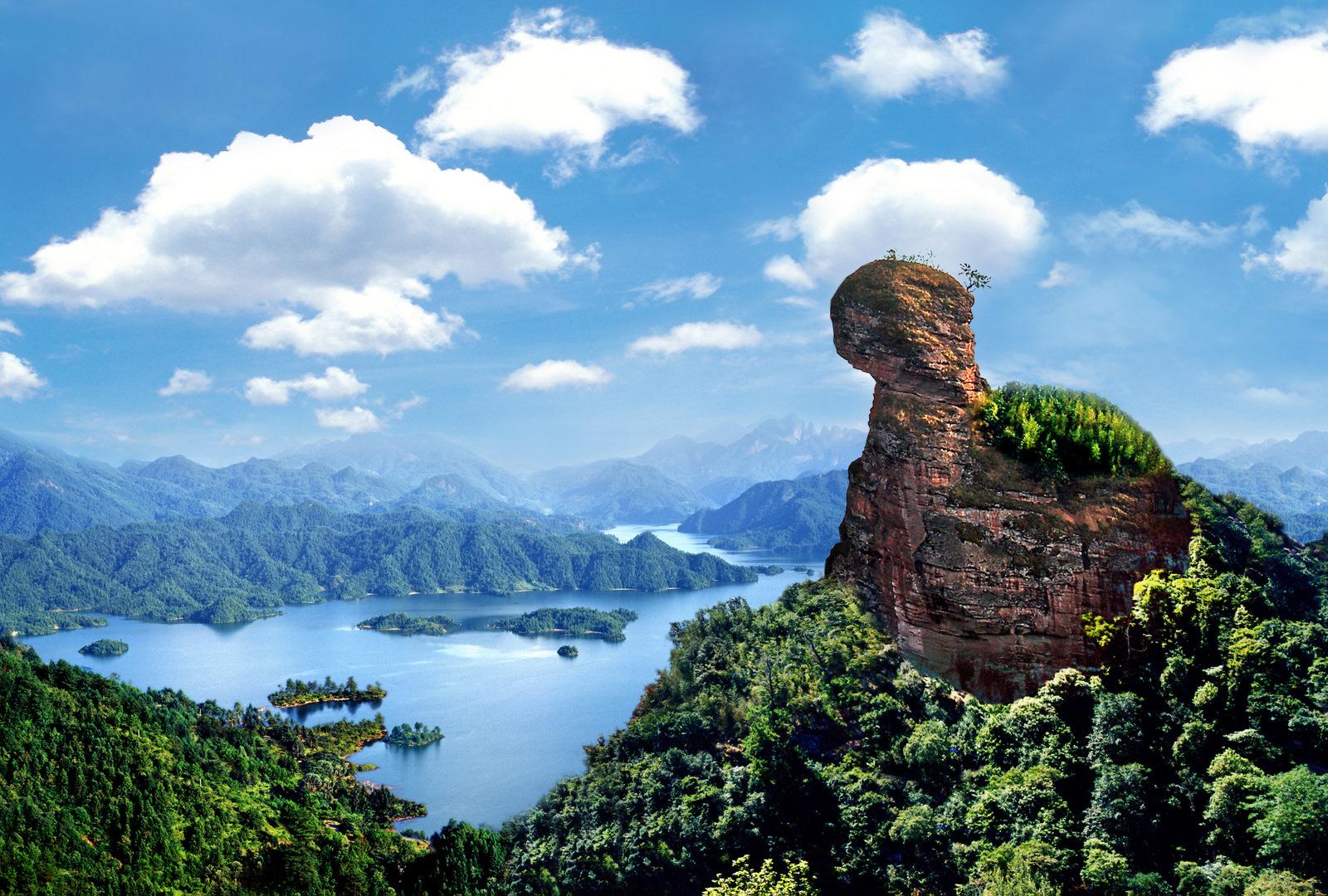
Deutsch-Chinesische Enzyklopädie, 德汉百科




Der Karakorum ist ein bis zu 8611 m hohes Gebirge in Südasien. Er trägt mit dem K2 den zweithöchsten Berg der Erde sowie mit Broad Peak (8051 m), Gasherbrum I („Hidden Peak“, 8080 m) und Gasherbrum II (8034 m) drei weitere Achttausender. Außerdem befinden sich hier 63 eigenständige Siebentausender und etliche Nebengipfel.[1] Der Karakorum erstreckt sich über den Norden Pakistans, Indiens und den Westen Chinas, Teile des Grenzverlaufs sind umstritten. Der Indus und dessen Zufluss Shyok grenzen den Karakorum von der Himalaya-Hauptkette im Südosten ab.
Das Gebirge hat eine Ausdehnung von etwa 700 Kilometern Länge und eine Breite von 100 bis 150 Kilometern und erstreckt sich in einem leichten Bogen von Nordwest nach Südost.[2]
Der Karakorum wird als höchstes Gebirge der Welt bezeichnet. Der höchste Berg der Erde, der Mount Everest, liegt zwar nicht im Karakorum, aber mehr als die Hälfte der Gebirgsfläche liegt oberhalb von 5000 Metern.[3] Das Tibetische Hochland liegt auf einer Höhe von 4500 bis 5000 Metern, ist aber relativ flach oder gewellt, wohingegen der Karakorum mit seinen steilen Bergen und tiefen Tälern die größte Fläche an topografischem Relief über 6000 Meter aufweist.[2]
カラコルム山脈(カラコルムさんみゃく,英: Karakoram range)は、パキスタン・インド・中国の国境付近に横たわる山脈である。アジアの大きな山塊の一部として広義のヒマラヤ山脈の一部であるが、狭義のヒマラヤ山脈とは独立した山脈である。氷河の多くが瓦礫に覆われている。カラコルムとはテュルク語・モンゴル語で「黒い砂利」という意味である。
カラコルム山脈には世界第2位のK2を筆頭に60座以上の標高7,000メートル以上の山が存在している。これらは主にパキスタンの北方地区(パキスタン名: ギルギット・バルティスタン州)に集中している。山脈の長さは500キロメートルにわたり、極地を除けば世界最大の氷河地帯もある。70キロメートルのシアチェン氷河と63キロメートルのビアフォ氷河は、極地を除けば世界で2・3番目に長い氷河である(最長はタジキスタンのフェドチェンコ氷河(77キロメートル)である)。
カラコルム山脈は、北東部でチベット高原に接し、北にはアフガニスタンとタジキスタンの国境がある。他にパミール高原にも囲まれている。北西部はヒンドゥ・ラジ山脈を経てヒンドゥークシュ山脈につながっている。南部は、インダス川・ギルギット川・ショーク川といった川によってヒマラヤ山脈との境界が作られている。
標高が高く起伏に富む地形のため、カラコルム山脈は人が住むのに適していない。ヨーロッパの探検家が最初にこの地を訪れたのは19世紀初頭だったが、その後イギリスの測量士が現地に入ったのは1856年であった。
マスタフ峠は1887年にフランシス・ヤングハズバンド大佐の遠征で横断された。また、フンザ川上流の谷は1892年にジョージ・コクリルによって探検された。その後1910年代から1920年代にかけての探索によって、この地域の地理の大部分が判明している。
The Karakoram is a mountain range spanning the borders of China, India, and Pakistan, with the northwest extremity of the range extending to Afghanistan and Tajikistan; its highest 15 mountains are all based in Pakistan. It begins in the Wakhan Corridor (Afghanistan) in the west and encompasses the majority of Gilgit-Baltistan (Pakistan) and extends into Ladakh (India) and the disputed Aksai Chin region controlled by China. It is the second highest mountain range in the world and part of the complex of ranges including the Pamir Mountains, the Hindu Kush and the Himalayan Mountains.[1][2] The Karakoram has eighteen summits over 7,500 m (24,600 ft) height, with four of them exceeding 8,000 m (26,000 ft):[3] K2, the second highest peak in the world at 8,611 m (28,251 ft), Gasherbrum I, Broad Peak and Gasherbrum II.
The range is about 500 km (311 mi) in length and is the most heavily glaciated part of the world outside the polar regions. The Siachen Glacier at 76 kilometres (47 mi) and the Biafo Glacier at 63 kilometres (39 mi) rank as the world's second and third longest glaciers outside the polar regions.[4]
The Karakoram is bounded on the east by the Aksai Chin plateau, on the northeast by the edge of the Tibetan Plateau and on the north by the river valleys of the Yarkand and Karakash rivers beyond which lie the Kunlun Mountains. At the northwest corner are the Pamir Mountains. The southern boundary of the Karakoram is formed, west to east, by the Gilgit, Indus and Shyok rivers, which separate the range from the northwestern end of the Himalaya range proper. These rivers flow northwest before making an abrupt turn southwestward towards the plains of Pakistan. Roughly in the middle of the Karakoram range is the Karakoram Pass, which was part of a historic trade route between Ladakh and Yarkand but now inactive.
The Tashkurghan National Nature Reserve and the Pamir Wetlands National Nature Reserve in the Karalorun and Pamir mountains have been nominated for inclusion in UNESCO in 2010 by the National Commission of the People's Republic of China for UNESCO and has tentatively been added to the list.[5]
Le Karakoram ou Karakorum est une chaîne de montagnes se trouvant dans la région montagneuse du Gilgit-Baltistan, au nord du Pakistan.
Il est situé à la frontière du Pakistan, de l'Inde et de la Chine et s'étend sur une longueur de plus de 500 kilomètres. Cette chaîne rassemble une très forte concentration de hauts sommets et il contient entre autres le deuxième plus haut sommet du monde (le K2, 8 611 m). Il est aussi celui où l'on recense le plus de glaciers, 135 de taille importante dont l'un des plus longs hors région polaire, le glacier du Baltoro avec ses 57 km, et surtout, le Siachen, long de 75 km (80 km en 1970). On dénombre huit glaciers de plus de cinquante kilomètres de longueur, ce qui représente un stock d'eau douce vital pour toutes les régions se trouvant en aval, particulièrement arides et enclines à subir des sécheresses. La présence de ces glaciers gigantesques est à l'origine du surnom donné au Karakoram : le « troisième Pôle ». Ces eaux contribuent fortement à l'alimentation du fleuve Indus situé au sud de la région et qui arrose 130 millions de Pakistanais.
Le Karakoram a les mêmes origines géomorphologiques que l'Himalaya, à savoir la collision entre les plaques indo-australienne et eurasienne. Il possède au sein du massif du Baltoro Muztagh quatre des quatorze sommets de plus de 8 000 m du globe (les dix autres sont dans l'Himalaya) : le K2 (8 611 m), le Gasherbrum I (8 068 m), le Broad Peak (8 047 m) et le Gasherbrum II (8 035 m). Les autres sommets remarquables sont le Chogolisa, le pic Haramosh, le Kanjut Sar, l'Ogre, le Rakaposhi ou encore le Saser Kangri, tous compris entre 7 000 et 8 000 mètres d'altitude.
Le col de Khunjerab, sur la Karakoram Highway, est le passage de frontière en activité le plus élevé du monde.
Il Karakorum o Caracorum (in entrambe le grafie, AFI: /karakoˈrum/ o /karaˈkɔrum/[1][2]; grafia alternativa Karakoram) è una sub catena montuosa situata a nord-ovest della catena dell'Himalaya, diviso da questa dalla fossa del fiume Indo, formando per circa 450 km il confine tra il Kashmir (pakistano e indiano) e la Cina e connettendosi verso ovest con la catena dell'Hindu Kush in Afghanistan.
Tra le zone del mondo più ricoperte da ghiacciai, con la sola esclusione delle calotte polari, a causa della sua altitudine e scabrosità è molto meno abitato rispetto all'Himalaya e al suo interno sono compresi 4 dei 14 ottomila esistenti sulla Terra.
La cordillera del Karakórum (del turco: "pedregal negro") es, con el Himalaya, una de las grandes cordilleras de Asia, situada en la frontera entre Pakistán (Gilgit-Baltistán), la India (Ladakh, en el estado Jammu y Cachemira) y China (región autónoma uigur de Sinkiang). Tiene una longitud de unos 500 km y es la región del mundo con más glaciares fuera de las regiones polares. Cinco de las catorce cumbres de más de ocho mil metros que existen en la Tierra se encuentran en esta cordillera.
Está rodeada, al este por la meseta Aksai Chin, al noreste por el límite de la meseta tibetana, y al norte por los valles de los ríos Yarkand y Karakash, más allá de los cuales se encuentran las montañas Kunlun. En la esquina noroeste están las montañas de la cordillera del Pamir. El límite meridional del Karakórum está formado, de oeste a este, por los ríos Gilgit, Indo y Shyok, que separan la cordillera del extremo noroeste de la cordillera del Himalaya. Estos ríos fluyen hacia el noroeste antes de dar un giro abrupto hacia al suroeste, hacia las llanuras de Pakistán. Aproximadamente en el centro de la cordillera del Karakórum está el puerto de Karakoram, que es parte de una histórica ruta de comercio entre Ladakh y Yarkand, ahora inactiva.
El Karakórum y los Himalayas son importantes para las investigaciones sobre la Tierra por diversas razones. Son una de las zonas del mundo de mayor actividad geológica, ya que están situadas en la zona en la que chocan dos continentes, Asia y el subcontinente indio. Además, son importantes para el estudio de las placas tectónicas debido al choque de las placas Euroasiática e Índica. Los glaciares de las montañas sirven como indicadores del cambio climático.
Каракору́м (кит. 喀喇昆仑山脉, урду سلسلہ کوہ قراقرم) — горная система Центральной (нагорной) Азии, одна из высочайших на Земном шаре. Находится на северо-западе от западной цепи Гималаев, между 34,5° и 36,5° с. ш. и 73,5° и 81° в. д.


高加索山脉(俄语:Кавказские горы,格鲁吉亚语:კავკასიონი,亚美尼亚语:Կավկազ,阿塞拜疆语:Qafqaz),呈东西走向,在黑海与里海之间,是俄罗斯和格鲁吉亚、阿塞拜疆等国的国界线。其最高峰为厄尔布鲁士峰,其海拔为5642米(18510呎),同时也是欧洲第一高峰。
大高加索山脉是亚洲和欧洲的地理分界线,从黑海东北岸,即在俄罗斯塔曼半岛至索契附近开始往东南偏东延伸,直达里海附近的巴库为止。 而小高加索山脉则几乎与大高加索平行排列,两者由隔开了科尔基斯和库拉-阿拉斯低地的苏拉姆山脉所连接。 在小高加索山脉东南方矗立着塔雷什山脉,是厄尔布尔士山脉的西北部分。 小高加索山脉和亚美尼亚高原构成了外高加索高地。
Der Kaukasus (russisch Кавказ, Kawkas; georgisch კავკასიონი, Kawkasioni, armenisch Կովկաս, Kowkas, aserbaidschanisch Qafqaz, türkisch Kafkas, von altgriechisch Καύκασος)[1] ist ein etwa 1100 Kilometer langes, von Westnordwest nach Ostsüdost verlaufendes Hochgebirge in Eurasien zwischen Schwarzem und Kaspischem Meer. Es ist Teil des Alpidischen Gebirgssystems und unterteilt sich in die drei Gebirgsketten Großer Kaukasus, Kleiner Kaukasus und Talysch-Gebirge. Der Kaukasus ragt bis zu einer Höhe von 5642 Metern über dem Meeresspiegel auf und hat eine mittlere Höhe von 602 Metern.[2] Er befindet sich auf den Territorien Russlands, Georgiens, Armeniens und Aserbaidschans. Im Jahr 2000 lebten etwa 30,6 Millionen Menschen in diesem Gebirge und seiner näheren Umgebung.
コーカサス山脈(コーカサスさんみゃく)は、黒海からカスピ海まで東西に走る山脈である。ロシア語からカフカース山脈ともよばれる。ロシアでは大カフカース山脈(Большой Кавказ)と呼び、南の小カフカース山脈(Малый Кавказ)と区別している。
ギリシア神話では、コーカサスは世界を支える柱のうちの一つでゼウスがプロメーテウスを鎖で繋いだ場所でもある。
The Caucasus Mountains[a] are a mountain system in West Asia between the Black Sea and the Caspian Sea in the Caucasus region.
The Caucasus Mountains include the Greater Caucasus in the north and Lesser Caucasus in the south. The Greater Caucasus runs west-northwest to east-southeast, from the Caucasian Natural Reserve in the vicinity of Sochi on the northeastern shore of the Black Sea nearly to Baku on the Caspian Sea. The Lesser Caucasus runs parallel to the Greater about 100 km (62 mi) south.[1] The Greater and Lesser Caucasus ranges are connected by the Likhi Range, and to the west and east of the Likhi Range lie the Colchis Plain and the Kur-Araz Lowland. The Meskheti Range is a part of the Lesser Caucasus system. In the southeast the Aras River separates the Lesser Caucasus from the Talysh Mountains which straddle the border of southeastern Azerbaijan and Iran. The Lesser Caucasus and the Armenian Highland constitute the Transcaucasian Highland, which at their western end converge with the highland plateau of Eastern Anatolia in the far north east of Turkey. The highest peak in the Caucasus range is Mount Elbrus in the Greater Caucasus, which rises to a height of 5,642 metres (18,510 ft) above sea level. Mountains near Sochi hosted part of the 2014 Winter Olympics.
La catena del Caucaso è un sistema montuoso che si estende per circa 1100–1200 km tra il mar Nero e il mar Caspio ed è a volte considerata il limite sud-orientale del continente Europa (in luogo della depressione del Kuma-Manyč indicata come tale nel 1730 dallo zar di Russia in seguito agli studi di Philip Johan von Strahlenberg).
La cordillera del Cáucaso1 (en ruso: Kavkazskiy Khrebet)? es una gran cordillera localizada entre el mar Negro y el mar Caspio, en la región del Cáucaso, entre las cuencas del río Kubán y del río Terek, al norte de Anatolia, y el río Irán, al sur. Muchas veces ha sido considerado el límite sudeste de Europa.
Muchas de las cimas de esta cordillera superan los 4.500 m, siendo la más alta el monte Elbrus, en el Gran Cáucaso. La cordillera es una gran barrera geográfica, casi infranqueable, con pocos pasos y collados, siendo los más importantes el Daryal y el Mamison. Posee considerables recursos hidráulicos como los del Kura y valiosas reservas de petróleo y gas natural.
Administrativamente, el Cáucaso pertenece a Armenia, Azerbaiyán, Georgia y Rusia (a las repúblicas autónomas de Karacháevo-Cherkesia, Kabardino-Balkaria, Ingusetia, Osetia del Norte - Alania, Chechenia y Daguestán).
Las montañas cercanas a Sochi fueron la sede de parte de los Juegos Olímpicos de Invierno de 2014.
Кавка́зские го́ры (абх. Кавказаа ашьхақәа, авар. Кавказалъул мугIрул, адыг. Къаукъаз къурш, азерб. Qafqaz dağları, арм. Կովկասյան լեռնաշղթա, груз. კავკასიონი, дарг. Кавказла дубурти, ингуш. Кавказа лоамаш, Даькъастен лоамаш, кабард.-черк. Къаукъаз къурш, карач.-балк. Кавказ таула, кум. Кавказ тавлар, лезг. Къавкъаз, осет. Кавказы хæхтæ, рут. Кавказад банбыр, чеч. Кавказан лаьмнаш) — горная система, расположенная в Евразии между Чёрным и Каспийским морями. Этимология названия не установлена[1]. Разделяется на две горные системы: Большой Кавказ и Малый Кавказ. Кавказ часто делят на Северный Кавказ и Закавказье, границу между которыми проводят по Главному, или Водораздельному, хребту Большого Кавказа, занимающему центральное положение в горной системе.
Большо́й Кавказ простирается более чем на 1100 км с северо-запада на юго-восток, от района Анапы и Таманского полуострова Чёрного моря до Апшеронского полуострова на побережье Каспия, рядом с Баку. Максимальной ширины Большой Кавказ достигает в районе меридиана Эльбруса (почти 180 км). В осевой части расположен Главный Кавказский (или Водораздельный) хребет, к северу от которого простирается ряд параллельных хребтов (горных цепей), в том числе моноклинального (куэстового) характера (см. Большой Кавказ). Южный склон Большого Кавказа большей частью состоит из кулисообразных хребтов, примыкающих к Главному Кавказскому хребту. Традиционно Большой Кавказ делится на 3 части: Западный Кавказ (от Чёрного моря до Эльбруса), Центральный Кавказ (от Эльбруса до Казбека) и Восточный Кавказ (от Казбека до Каспийского моря).
Наиболее известные вершины (такие, как Эльбрус (5642 м) и Казбек (5033 м)) покрыты вечными снегами и ледниками. Большой Кавказ — регион с большим современным оледенением. Общая численность ледников составляет около 2 050, занимаемая ими площадь составляет приблизительно 1 400 км². Больше половины оледенения Большого Кавказа сосредоточено на Центральном Кавказе (50 % от числа и 70 % от площади оледенения). Крупными центрами оледенения являются гора Эльбрус и Безенгийская стена (с ледником Безенги, 17 км).
От северного подножия Большого Кавказа до Кумо-Манычской впадины простирается Предкавказье с обширными равнинами и возвышенностями. К югу от Большого Кавказа расположены Колхидская и Кура-Араксинская низменности, Внутреннекартлийская равнина и Куринская впадина, в пределах которой находятся Алазань-Авторанская долина и Кура-Араксинская низменность. В юго-восточной части Кавказа — Талышские горы (высота до 2492 м) с прилегающей Ленкоранской низменностью. В середине и на западе южной части Кавказа находится Закавказское нагорье, состоящее из хребтов Малого Кавказа и Армянского нагорья (высшая точка — г. Арагац, 4090 м). Малый Кавказ соединяется с Большим Кавказом Лихским хребтом, на западе отделяется от него Колхидской низменностью, на востоке — Куринской впадиной. Протяжённость — около 600 км, высота — до 3724 м.

汗腾格里峰(英语:Khan Tengri、哈萨克语:Хан Тәңірі / حان ٴتاڭىرى、吉尔吉斯语:Хан-Теңири / حان-تەڭىرى)位于东经80.2°,北纬42.2°,中华人民共和国,哈萨克斯坦和吉尔吉斯斯坦国界线上[2]。它是天山山脉的第二高峰,也是哈萨克斯坦的最高峰,在天山山脉中科克沙勒岭与哈尔克山的结合部位,海拔6,995米(包括冰川帽为7,010米)。位于托木尔峰北面,西邻吉尔吉斯斯坦境内伊塞克湖盆地,北邻伊犁河谷地,南邻塔里木盆地北缘的阿克苏绿州。汗腾格里峰一带地势高峻,山岭海拔多在4,000米以上,6,000米以上的高峰多达40座,山地大面积突出于雪线之上。汗腾格里峰南北面为南Engilchek Glacier和北Engilchek Glacier,南Engilchek Glacier最上游16公里在中华人民共和国,北Engilchek Glacier最上游14公里在哈萨克斯坦。


 Geography
Geography





 Afghanistan
Afghanistan